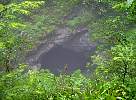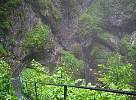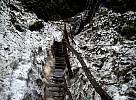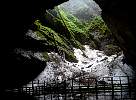



Back in Romania. I headed for the Bucegi mountains north of Bucharest in November 2006 (More about this here.)
So where should I go this time?
I seemed like a good idea to combine my interest in caves and my interest in cold places and head for the Scărişoara Cave, which is an ice cave (the second largest in Europe).
The disadvantage?
It's quite some distance away from Bucharest (nearly 500 km) and except for about 100 km highway, most of the roads are rural roads. Not that bad in itself, but most of the villages stretch out along these roads, so for a large part of the way, you are driving through villages, which reduce the travelling speed significantly.
So in the end, it took me more than ten hours to drive from Bucharest to the Apuseni Mountains.
Then I had a day to spend in that area, before driving back to the Bucharest area (actually to Ploieşti, which added another 50 kilometers to the trip) on the following day.
Was it worth spending three vacation days, just to see an ice cave somewhere in the Western Carpathians?
Well...
...the cave is not really that impressive, but it's ok.
But then again, I once read that reviews tend to overly praise thick books, just because of the sheer relief from having read through them.
Certainly there's a bit of relief in actually having reached the ice cave. Not only is it a long drive from Bucharest to get there, but it's also a bit of a walk.
From Garda de Sus there are a number of hiking trails to the ice cave. The shortest is about six kilometers long and involves an altitude difference of about 450 meters.
You can also drive to the cave by car, but that's an 18 kilometer drive over rubble, which is not hard to do and can be easily done with normal cars (no 4x4 required), but I didn't want to risk damage to the rental car and walking seemed like a good idea.
After a couple of days in Bucharest, where the temperature was around 34°C, it was nice to having a bit of a colder day for walking. What was slightly less nice (but refreshing) was to walk most of the way to the cave in pouring rain...
But finally I arrived at the cave, paid my entrance fee and was happy to find out that the guided tours are sort of optional when there aren't many visitors. Usually there are only seven tours per day through the cave, mainly to reduce 'local warming' in the cave by having too many warm people in the cave for longish periods of time.
On a day with cold weather and only a few visitors, they are allowed to go down to the cave on their own. Which was nice, since it's more fun to spend time in a cave (and take photographs) when you are not in a big group. I even had the ice cave to myself for about ten minutes.
Essentially the ice cave is just a side hall to a big hole in the ground. There is a set of stairs going down the hole to the entrance of the cave.
In summer, there isn't actually that much ice that can be seen by visitors. The big mass of ice forms the floor of the cave (what looks like the floor is actually the top of the ice - the real cave floor is about 25 meters below) and in summer the surface of the ice melts, so the ice is covered by a couple of centimeters of water, so the basic appearance is that of a very shallow cave lake.
In winter, the lake freezes solid again and interesting ice formation and big icicles form on the ceiling. But in summer, most of the ice formations near the entrance melt (there was one big, broken off icicle right next to the entrance).
There is, however, a small side chamber towards the back of the main cave, where the warmth takes longer to penetrate and some ice formations still remain in July.
One important lesson: Coming into the cave, wearing a soaking wet t-shirt from the rain outside, you quickly learn about hypothermia and why it is generally a good idea to stay dry in cold environments...
Luckily, I don't mind being cold (at least not much), but the effect was noticeable.
After visiting the cave, it was time to head back to Garda de Sus and taking a look at the local scenery on the way. (There wasn't much chance of looking at the distant scenery, due to clouds, rain and foggy weather...)
The ice cave is a surprisingly popular destination. When I left there, about a dozen people were waiting for the guided tour (the group had gotten too large to just allow them in on their own) and on the way back, quite a few walkers (and cars) walked along the track. Not talking about big crowds here, but seeing a couple of dozen people walking and driving around in rather mediocre weather was quite surprising.
Close to Garda de Sus, there is another small cave called "Poarta lui Ionele". Since it's only a kilometer way and at about the same altitude, it was worth the short walk.
It's mainly a big hall, with a short extension to one side, a large entrance and a small stream that has it's spring right at the cave entrance. It looks like the perfect place for a small stone age tribe to have lived in...
Some other people visited the cave as well and they recommended the 'Bear Cave' (Peştera Urşilor). While the direct distance from the ice cave is not that big (only about 20 km), the driving distance is closer to 80 km, a significant part of it along winding mountain roads. I wasn't sure whether I would make it to the cave before closing time (5 pm), but decided to give it a chance.
This additional trip was definitely worth it.
The nice thing about the Bear Cave is that it has been discovered comparatively late (in 1975) and then immediately been protected and prepared as a show cave, so most of the stalactite/stalagmite formations are still intact and not been destroyed by museums, souvenir collectors or the hacking of visitor paths and steps into the cave walls themselves.
So it is a large cave that is in very good condition and quite impressive.
Since it's a show cave, access is only in guided groups, but for an additional fee, pictures can be taken (which surprisingly uncommon for show caves). It's a bit tricky to take long exposure photographs during a guided tour, but it's fun to try.
The Bear Cave got its name from the Cave Bear skeletons found there (it seems that the original entrance to the cave collapsed 15000 years ago and trapped more than a hundred bears inside the cave). One of the skeletons is displayed prominently in one small side hall of the cave. (This is arranged for 'dramatic purposes' - the bones belong to more than one bear. It wasn't quite clear during the guided your whether these were the actual bones found or plaster copies.)
On the next day it was time to drive back towards Bucharest and onwards to Ploieşti. I took the scenic route along Transfăgărăşan, which is a mountain road through the Carpathians and the highest road in Romania and offers great views.
On a clear day.
Too bad the road looked like this when I drove there.
So the view of the landscape beside the road looked essentially like this:
AT least the cloud layer had a clearly defined lower limit, so once reaching a certain altitude below the peak, there was a bit of a view of the countryside.
One additional challenge while driving along the Transfăgărăşan in the fog are the number of sheep grazing at the hillsides next to the road and sometimes right on it.
After more than 600 km and 11 hours drive, I finally arrived at the hotel in Ploieşti.
So why go to Ploieşti at all, instead of just driving to Bucharest?
One reason, of course, was the traffic situation in Bucharest. I had to go to the airport the next day and driving from Bucharest to the airport takes a somewhat indeterminate amount of time, while driving from Ploieşti was a bit more predictable.
The main reason, however, was that I wanted to drive a bit further to the North from Ploieşti to take a picture that I missed the first time when I was in Romania. The road from Ploieşti to Braşov crosses the 45th northern degree of latitude and there is a marker next to the road.
Since I took a similar picture of the 45th southern parallel in New Zealand a couple of years ago, I wanted to have a picture of a northern counterpart, halfway between the equator and the North Pole.
And then it was time to drive to the airport and fly home...